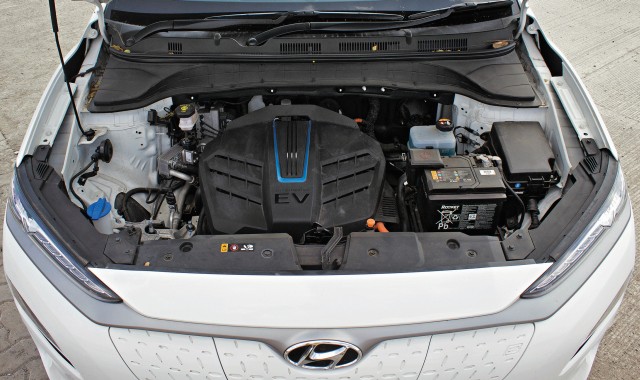
The Kona Electric is a unique experience for anyone who has never gotten behind the wheel of an electric or hybrid car before. Foot on the big brake pedal, push the start button and the driver info display lights up with a soft “ding”. And that’s it. It’s on. A light touch of the accelerator pedal is all that’s needed. There’s no throttle valve or injection control, it’s just drive-by-wire. Charge flows from one wire to another, through the control electronics and the single-speed transmission, to the front axle. The 100-kW motor is capable of putting out the equivalent of 136 hp and a wholesome 395 Nm of torque — as much torque as the average atmospheric 4.0-litre V8 petrol engine! Unlike a V8 petrol engine that needs to rev up before it begins to get a move on, an electric motor works at the speed of sound. Electric current is run through a magnet and it begins rotating at speed — almost instantaneously. That gives some incredible acceleration figures as well. Lift off the brake once you prod the smaller pedal and there is a momentary squeal from the front wheels before the head snaps back and your gut discovers the meaning of inertia.
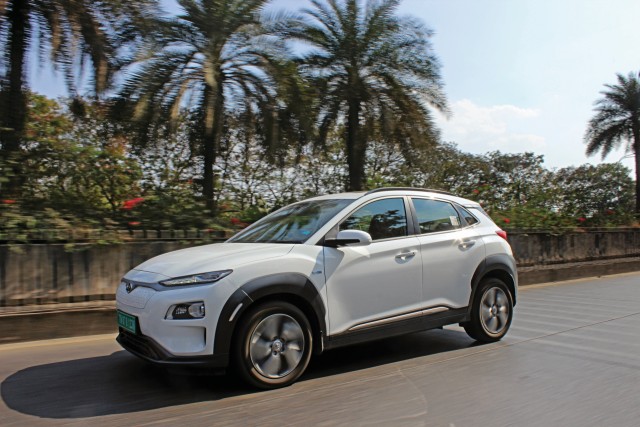
The Kona Electric can accelerate from standstill to 100 km/h in 8.3 seconds, nail the quarter-mile in 16 seconds, and go on to a limited top whack of 159 km/h. But, again, those are just numbers — and they compare with some premium offerings almost twice that price — and the way the Kona behaves is what is infinitely surprising for quite some time. There’s no engine noise, so everything from the road noise to the sound of grass and gravel crunching together under the tread is audible, to some extent, inside the cabin.
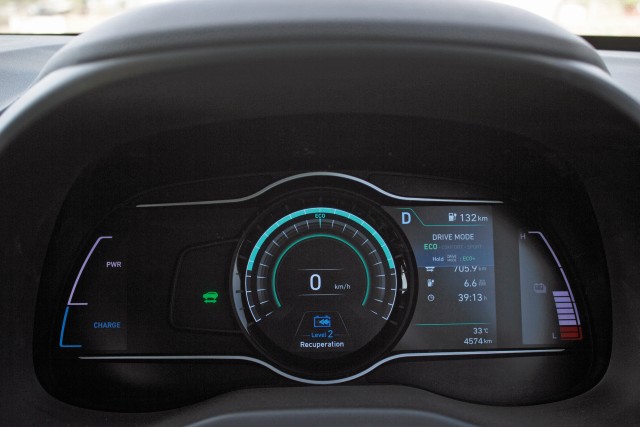
Then there are the drive modes: Sport, Comfort, Eco, Eco Plus. Yes, I’ve listed them in order of preference. The acceleration is pretty much the same regardless of the mode selected; however, one thing that’s very different is the way the Kona Electric regenerates energy from braking. There are four regeneration settings, from “0” to “3”. In Comfort and Sport, it’s mode “1” as standard and there is no perceptible feel of brake-energy regeneration with the Kona running smoothly. Eco and Eco Plus, obtained by holding down the Drive Mode button, allow three stages of regeneration, with the standard being mode “2”. This feels different because the Kona begins recuperating the moment the foot leaves the pedal; it almost feels like engine braking. Flick the right paddle and it feels even more potent as mode “3” is selected. Top speed is restricted to 90 km/h in Eco Plus mode.
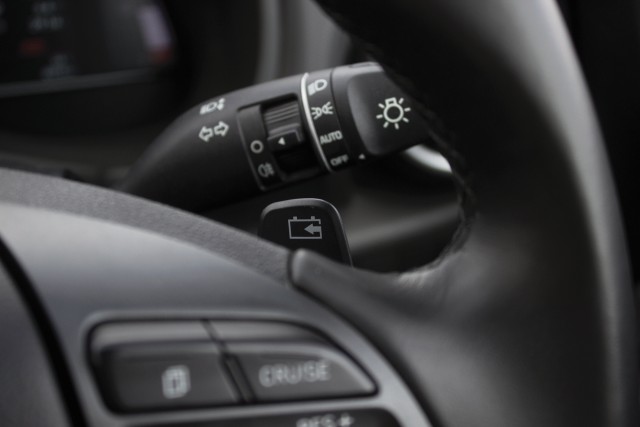
I stayed in Eco with regen mode “2” for the most part as it was interesting to see what sort of distance I could gain lifting off at speed and when going downhill. It gains a couple of hundred metres lifting off at speed before stepping on the brakes; however, a good downhill stretch of 200 metres or more recuperates enough for an indicated 1.4 kilometres! Let me also mention that when I’d taken the Kona for the night from office, it had 156 km of range left with just about half the charge remaining. When I returned the next day to work, it was 154 km! While the city figure for the Kona Electric was just over 10 kWh/100 km – we need to get used to that one – the overall electricity consumption worked out to 12.2 kWh/100 km.
Eventually, the Kona Electric needed charging. An overnighter on the AC socket saw it take about 11 hours to a full charge from just about a third of the 39.2-kWh battery pack. Coming to the all-important figure: range! Hyundai claim 452 km on a full charge. We saw 339 km. However, this figure takes into account previous driving patterns and changing that should entail a different figure displayed the next time round. Nevertheless, it’s more than enough for a daily commute of even 50 km a day, to and fro, for a work-week.
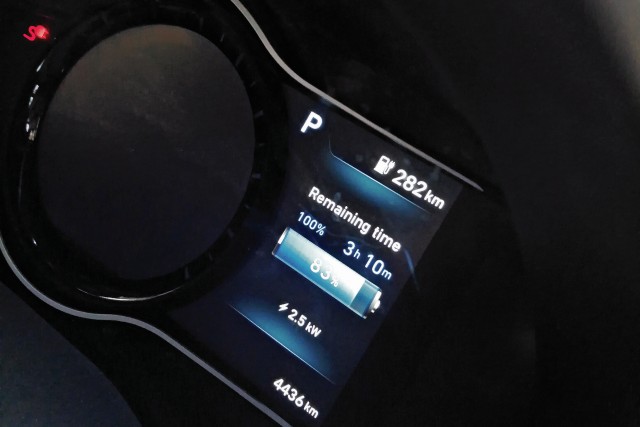
A point we have to consider is that the Kona Electric is more likely to be a second car for many of its buyers. Thus, it would probably be subjected to a variety of uses, but primarily be a runabout. Some insiders say that while some tour operators who do 200 km a day are fine with a range of 400 km, it’s actually the ones who travel 20-30 km a day that actually have a worse case of range anxiety. Moreover, the battery retains charge well and, from what we’ve been informed, the loss is barely a couple of percentage points over a month. Yes, it’s fine and the anxiety, at least in this scenario, shouldn’t exist as the car can work well as a daily-driver. It’s clean, stress-free, and there’s no need for start/stop because it doesn’t have to deal with idle fuel consumption of zero km/l.
I have to say I was impressed by the Kona Electric as a daily. It works just as well as any car, but the silence and sense of calm inside the cabin are admirable and hugely appreciated. If only I knew my electricity was coming from the sun or other forms of renewables, I could figuratively drive with a halo on my head. The Kona Electric works in every scenario, functions well in many roles, and does so with aplomb. It gets a thumbs-up from me.
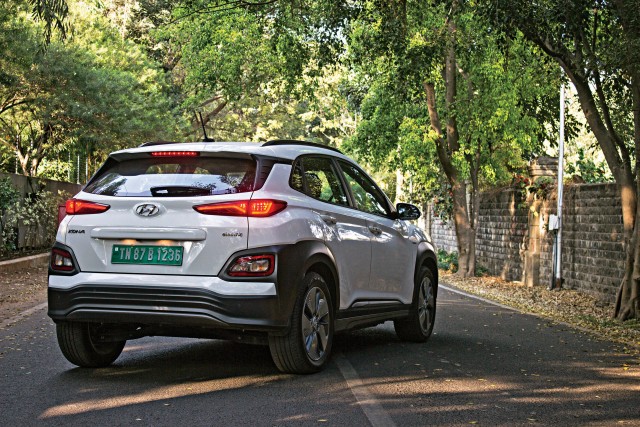
Need to Know – Hyundai Kona Electric
Price: Rs 23.72 lakh (ex-showroom)
Electric Motor: 100-kW, permanent-magnet synchronous
Max Output: 136 hp, 395 Nm
Transmission: Single-speed, automatic, front-wheel drive
Battery Pack: 39.2 kWh, lithium-ion, 327-volt, 90-cell
Max Charge: 7.2 kW
Charge Time: 19 hours (trickle), 6.1 hours (AC), 75/54 minutes (DC 50/100 kW)
Suspension: MacPherson strut front, multi-link rear
Weight: 1,593 kg
The Other Need-to-know of EVs
Battery Performance
Battery performance and durability can deteriorate drastically if the DC charger is used constantly. Thus, DC fast-charging should be minimized and only used in emergencies in order to prolong the life of the high-voltage battery.
Towing
Make sure you park properly or else your vehicle may be towed. The problem there is, the motion of the front wheels, when touching the ground, may cause the drive motor to generate electricity and the motor components may be damaged or, worse, a fire may occur. When a fire occurs, there is a risk of a second fire due to the battery. Contact the fire department when towing the vehicle. If towing is required, all four wheels must be lifted off the ground. If it must be towed using only two wheels. The driven wheels ― front, in this case ― have to be lifted off the ground.


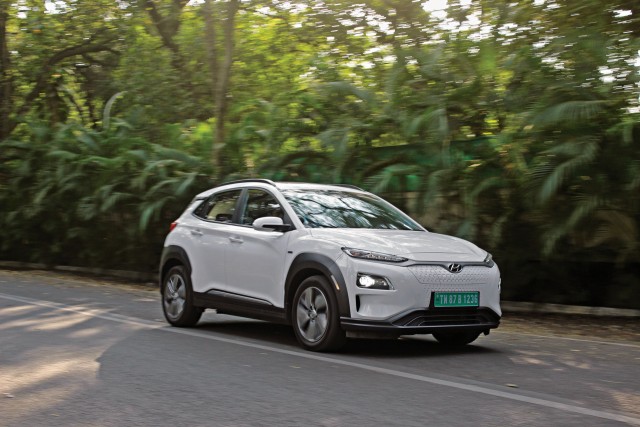


















Leave a Reply